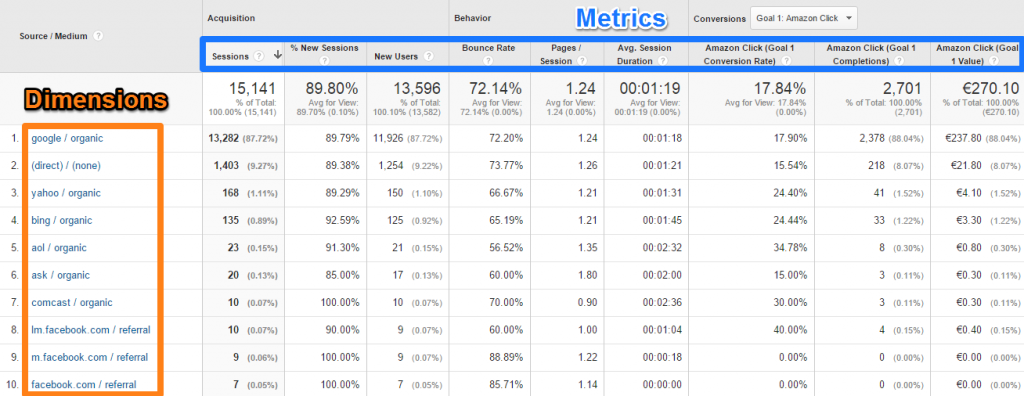Unveiling the 'Secondary Dimension' in Google Analytics: What You Need to Know
Unveiling the 'Secondary Dimension' in Google Analytics: What You Need to Know
Blog Article
Translating the Significance of Additional Dimension in Google Analytics: All Regarding Its Importance and Impact
In the realm of electronic analytics, the use of second dimensions within Google Analytics offers as a pivotal tool for critical deeper layers of data insights. The relevance of secondary measurements lies in their capability to offer a nuanced view of individual habits and interaction with an internet site or system.
Understanding Secondary Measurements in Google Analytics
The understanding of additional dimensions in Google Analytics is vital for obtaining deeper understandings into customer behavior and internet site efficiency. While main measurements offer essential data factors such as website traffic sources and page views, secondary measurements permit a much more nuanced evaluation by offering added context to these primary metrics. By including secondary dimensions, customers can sector and filter their data to discover patterns and patterns that may not be right away obvious.

Revealing the Benefits of Second Measurements
Structure upon the fundamental understanding of additional dimensions in Google Analytics, discovering the benefits they use exposes indispensable insights for boosting information evaluation and decision-making. By incorporating secondary measurements, users can delve much deeper into their information, obtaining a much more comprehensive sight of user behavior, material efficiency, and various other vital metrics.
Additionally, additional measurements give context to key information, using extra layers of info that can aid in understanding customer interactions and preferences. This enhanced understanding can direct strategic decision-making, leading to more targeted advertising and marketing projects, website optimizations, and overall enhanced performance. Essentially, additional measurements function as a powerful device for unlocking deeper insights and making best use of the energy of Google Analytics for companies and site owners.
Leveraging Additional Measurements for Enhanced Insights
By using the power of additional dimensions in Google Analytics, services can discover much deeper understandings that drive educated strategic and decision-making optimization efforts. Leveraging additional dimensions permits organizations to delve past surface-level data and obtain a more extensive understanding of individual habits, audience demographics, website traffic sources, and site performance. By combining main measurements like website traffic resources with second measurements such as geographical location or device classification, companies can determine which tools or regions are driving the most valuable traffic to their site.
Moreover, secondary dimensions enable services to sector and analyze data more successfully, helping them determine patterns, patterns, and chances that might have or else gone undetected. By making use of second dimensions, services can tailor their advertising and marketing approaches, web content, and user experience to far better meet the needs and preferences of their target audience. Essentially, leveraging secondary dimensions in Google Analytics encourages organizations to make data-driven decisions that bring about boosted performance, enhanced ROI, and lasting development.

Impact of Additional Dimensions on Data Analysis
Enhancing information evaluation via the usage of second measurements in Google Analytics check this offers companies with a much deeper understanding of their on the internet performance metrics. By integrating additional dimensions, such as time of day, geographic place, or device classification, businesses can reveal important understandings that may have been overlooked with key measurements alone. This enhanced level of granularity permits even more precise division of data, allowing organizations to identify patterns, trends, and relationships that can drive calculated decision-making.

Making Best Use Of Potential: Additional Capacities Methods
One vital approach is to integrate second measurements with main weblink dimensions to acquire a detailed view of customer interactions. Combining the primary measurement of 'source/medium' with secondary measurements like 'touchdown page' or 'gadget group' can reveal which channels are driving web traffic to details web pages or how customer actions differs throughout tools.
Additionally, using second measurements to segment data based upon user demographics, behavior, or technology can aid services customize their marketing efforts to specific target market sections. This targeted approach can bring about boosted conversion prices, enhanced user experiences, and inevitably, boosted ROI. By making the most of the potential of secondary dimensions in Google Analytics, services can make enlightened choices, enhance their online presence, and drive sustainable growth.
Verdict
In conclusion, second dimensions in Google Analytics play a critical function in supplying much deeper insights and improving data evaluation. By making use of additional dimensions properly, services can obtain a more thorough understanding of individual habits and internet site efficiency. Including secondary measurements into data analysis techniques can result in even more informed decision-making and boosted general efficiency. It is vital for businesses to utilize the power of secondary dimensions to optimize their possible and achieve higher success in their online undertakings (what is a “secondary dimension” in google analytics?).
While key measurements supply fundamental information factors such as traffic resources and page sights, secondary measurements allow for a much more nuanced analysis by giving added context to these key metrics. By combining main dimensions like web traffic sources with second dimensions such as geographical location or gadget classification, companies can recognize which regions or tools are driving the most important web traffic to their internet site.
By integrating additional measurements, such address as time of day, geographical location, or tool classification, companies can uncover valuable understandings that might have been neglected with main dimensions alone. One crucial approach is to incorporate second measurements with main measurements to obtain an extensive view of customer communications. Matching the key dimension of 'source/medium' with second dimensions like 'landing web page' or 'gadget group' can disclose which networks are driving web traffic to certain web pages or exactly how customer habits differs throughout gadgets.
Report this page